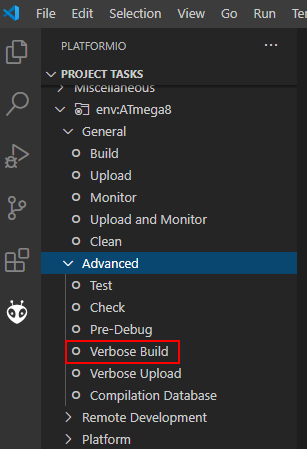Hi, Is there anyway to add the verbose in platformio.ini?
Best regards.
Thanks a lot @ivankravets
But I tried many times, such as “build_flag=verbose”, “force_verbose=yes”, “output=verbose”,etc. All of them are failed.
Can you give me an example about how to use “verbose” in the platformio.ini file?
By the way, If I want to let the platformio project generate the “main.c” file, not the “main.cpp” file, when creating the avr-arduino project in the project creating wizard (I will delete the “framework=arduino” in platformio.ini file for native avr programming), is there anyway to do it? I find that some functions have errors in “.cpp” file, but the errors disappeared if I just modify the “main.cpp” to “main.c” manually.
Best regards.
After many attempts, I find that there is a command line in the “TERMINAL” tab:

And the “Verbose Build”:

Hope this information helps the beginners who needed.
That does not seem to be working as one would expect. At least not when using VS Code with platformio.
When you set:
force_verbose = yes
And you then compile, you still get a message that you can user "–verbose"for verbose output. And your compile still isn’t verbose. So that setting has no effect on compile output.
The screenshots of @wgt do work (aka, click Verbose Build in platformio itself).
It would be really helpful (and much more intuitive) if force_verbose = yes would effectively do a verbose build too.
Edit
I’m wrong… kind of.
When one does: pio settings set force_verbose 1 then it does work as expected.
I have no clue where this setting is supposed to be stored in config files. It definitely doesn’t work in your project settings platformio.ini.
It also doesn’t work if one does:
[platformio]
force_verbose = yes
… I know how to get it working now (executing that pio command) but i find it super vague and magic that it does work now.
The correct way to do this is to use -v or --verbose in the build flags inside platform.ini file like this: build_flags = -v
I didn’t find how to add it in platformio.ini but it’s possible to controll it through the custom test runner. I’ve added simple porxy layer
class CustomTestRunner(UnityTestRunner):
def setup(self):
self.options.verbose = 2